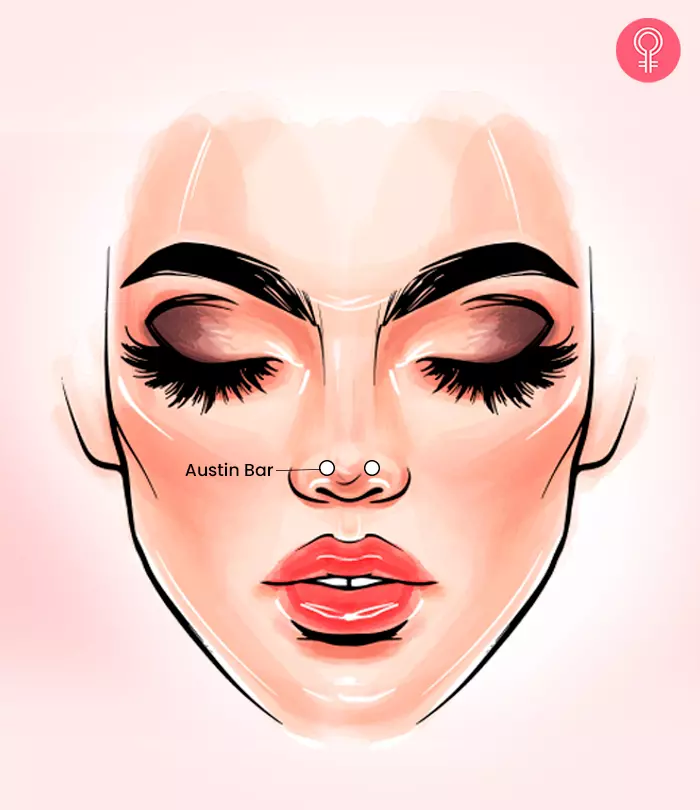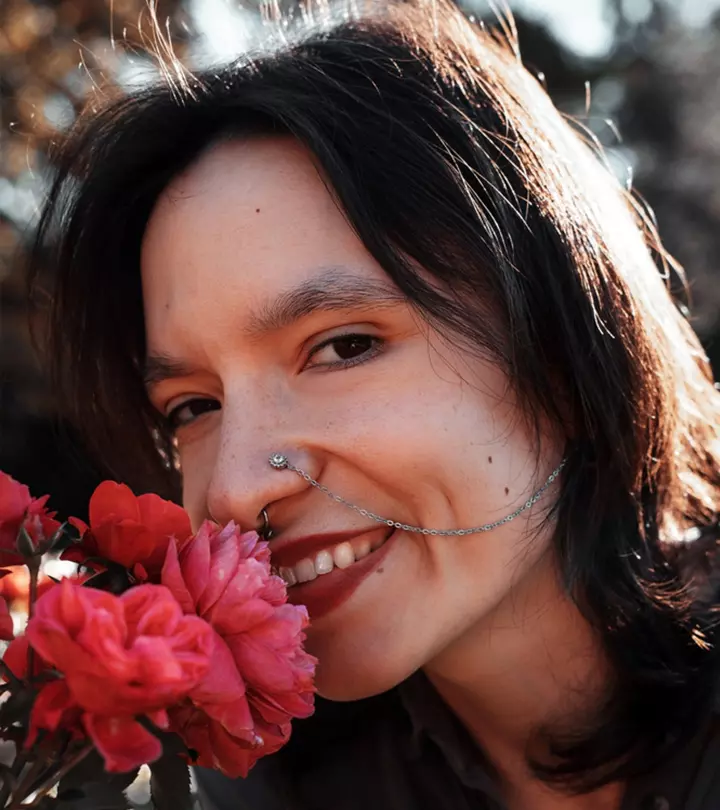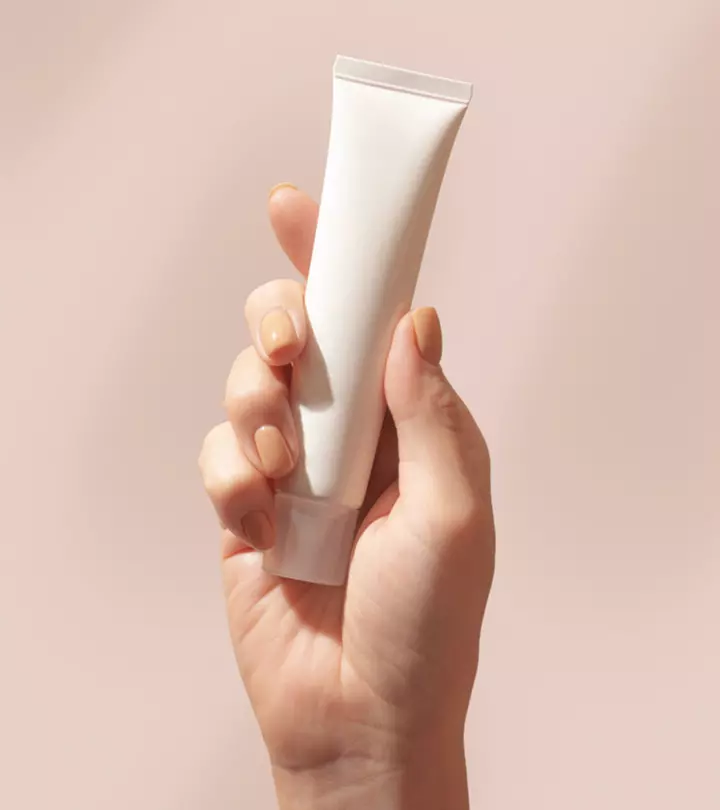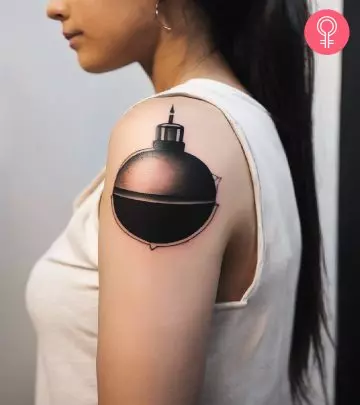Does A Nose Piercing Hurt? What You Need To Know
Do not let the pain of a nose piercing intimidate you from getting a modish look!

Image: Shutterstock
Nose piercings have been a timeless form of body adornment. Women across ages have worn them, and the trend never seems to fade. The look, of course, has transcended cultural boundaries and became a globally embraced fashion statement. However, do nose piercings hurt? While they sure do enhance your appearance, understanding the pain involved during the process is important too. At its core, a nose piercing involves the insertion of a sterilized needle and then the selected jewelry piece through the soft nose cartilage. This accentuates the facial features of the individual.
However, the pain associated with a nose piercing is what worries certain individuals. If that sounds like you, this article can help. Here, we discuss everything you need to know about nose piercing, including what to look for before booking a piercing session, the pain involved, and the right measures to take to deal with the intense sensation. Continue reading.
In This Article
Does A Nose Piercing Hurt?

For many individuals, the pain can be brief but like any other piercing, the overall process can bring some discomfort. Many describe it as a quick pinch with mild redness and soreness. However, the pain level also depends on the individual’s personal tolerance, skin thickness, and piercing location.
 Trivia
TriviaBut despite the common discomfort during the piercing procedure, there are other factors that may contribute to the pain as well. Scroll down to learn more about them.
Key Takeaways
- A nose piercing can bring initial discomfort but is considered moderate in terms of pain level.
- There are different types of nose piercings such as nostril, septum, and bridge that bring their specific pain level.
- Certain precautions can be taken to reduce the pain during a nose piercing, like avoiding alcohol and caffeine and going with a full stomach.
- A sterilized needle of size 18 gauge to 20 gauge is often used to make a nose piercing.
What Factors Can Affect Nose Piercing Pain?

Apart from experiencing discomfort during the piercing process is usual and individual pain threshold, piercing location, and type of nose piercing, certain factors may affect the overall pain. For instance, the prowess of the professional piercer, piercing technique, and hygiene can also impact the overall pain.
To get an insight into the different types of nose piercings and their pain level, check out the section below.
How Bad Does A Nose Piercing Hurt?

Just like the skin’s thickness, the location of the piercing influences the pain level such as cartilage piercings and high nostril piercings can be more uncomfortable than other softer areas. Let’s have a detailed look at the different types of nose piercing below and their rating on a pain scale between 0 and 10.
- Nostril Piercing: Nostril piercing usually brings mild discomfort during the piercing process. They cause a brief stinging sensation, which can be compared to a quick pinch. The pain level is 3/10.
- Septum Piercing: Septum piercing causes moderate pain that can last a few seconds. You can experience minimal soreness and tenderness in the following hours as well. While discomfort is there for about a day, it is generally tolerable. The pain level is around 5/10
- Bridge Piercing: Bridge piercing also causes moderate pain during the piercing session. Subtle throbbing can also be felt after the piercing, followed by mild soreness for a day or two. The pain level is around 4/10.
- High Nostril Piercing: High nostril piercing inflicts moderate pain and has similar discomfort to bridge piercing due to the thickness of the skin. Sharp sensations can be felt, accompanied by soreness and redness for a day. The pain level is 5/10.
Tarila, a blogger, shared her first encounter with a nose piercing and how the overall experience went. She recounts the pain level during the actual piercing process and states, “It doesn’t hurt as much, It hurts no different to a mosquito bite. Honestly, I have low pain tolerance and I’m saying it doesn’t hurt as bad as you would expect (i).”
Now that we are aware of how much a nose piercing can hurt, let us understand how long you should expect the discomfort to last in the section below.
How Long Does A Nose Piercing Hurt?
While the actual piercing procedure may last only a second or two and bring sharp pain, the overall pain duration can last anywhere from one to three weeks. Initial discomfort, tenderness, swelling, and bruising can be expected, but by following proper aftercare instructions, you can achieve a completely healed nose piercing in 4-6 months.
If you wish to understand the piercing process in detail, then check out the section below as we talk about what you can expect at the piercing shop.
What To Expect At The Studio?

Firstly, you may want to select a piercing studio that offers a clean environment, an experienced piercer, and ideal permits and licenses. Further, your piercer and other staff should be knowledgeable and be able to answer basic questions like: How long does a nose piercing take to heal? What are safe aftercare measures? etc. The actual process involves marking the piercing spot, cleaning the skin area, then using a sterilized needle of 18 to 20 gauge for insertion, and attaching a titanium, surgical steel, or gold jewelry piece.
 Trivia
TriviaIf you are someone who is adamant about getting a nose piercing but does not deal with pain very well, then check out the section below as we talk about simple ways to combat the pain and achieve a stunning result. Scroll down.
Ways To Deal With Nose Piercing Pain
There are numerous things you should keep in mind to reduce the pain that is often brought during the nose piercing process. Let’s read about them below.
- Listen To The Piercer’s Instructions
Adhering to the professional piercer’s instructions is extremely important if you wish to experience a smooth healing process. These are especially crucial for first-timers.
- Consume A Proper Meal
It is never a good idea to visit a piercing shop on an empty stomach as this act can lead to the feeling of nausea or dizziness.
- Skip Caffeine
The natural anticoagulant effects in caffeine may thin blood (1). This can hamper the blood clotting process and cause excess bleeding during the piercing procedure.
- Avoid Alcohol
Alcohol has a similar effect to caffeine and can thus make your blood thinner and cause more bleeding (2).
- Use A Numbing Cream
Applying a thin layer of numbing cream or gel may help reduce the pain during a piercing session. Ensure to use the cream thirty to forty minutes before the procedure (3).
- Drink Adequate Water
Staying well-hydrated during a piercing session is important to prevent dizziness and unwanted tiredness.
- Try Cold Compresses
Applying a cold compress gently around the nose can help numb the area and reduce pain. Make sure not to press too hard on the piercing itself.
- Practice Deep Breathing
Use deep breathing exercises to stay calm and manage pain levels. Focusing on your breath can help distract you from the discomfort.
- Avoid Touching Or Twisting
Resist the urge to touch or move the piercing, as this can increase irritation. Keeping hands off the area helps with faster healing and less pain.
Just like other types of piercings, a nose piercing can also bring discomfort but it is slightly alarming when the pain continues. So, scroll down as we learn when is the right time for some medical attention.
When To See A Doctor
A fresh nose piercing naturally brings subtle discomfort, redness, and bleeding. The initial healing days will also be characterized by swelling and warmth but you can expect the piercing to be majorly healed in 2-4 months. However, extra attention would be required if you are still feeling some level of pain and there is visible inflammation, redness, yellow discharge (pus), and a piercing bump. It is then advised to visit a doctor and address the problem professionally. Visit your healthcare provider if you notice pus formation after a fresh piercing.
The initial discomfort during the procedure is often described as a brief pinch but the pain level can vary depending on the individual’s pain tolerance. There are certain tips one can keep in mind as well to reduce the discomfort during the session, like using topical anesthetic and avoiding alcohol. The healing process typically involves mild soreness and redness that eventually settles down over weeks. In our opinion, a nose piercing looks truly stunning and can be a popular choice for many but learning about different types of piercings and their pain level is also important. So, if it is something that you have been planning for a while now, then without a doubt go ahead and spruce up your nose anatomy.
Frequently Asked Questions
Does changing my nose piercing for the first time hurt?
Yes, changing a fresh piercing for the very first time can bring discomfort and pain and even lead to some skin irritation. It is suggested to use saline solution before and after the switching of the jewelry to ease the pain.
Why does my nose piercing hurt on the inside?
Certain factors can lead to pain from the inside of a nose piercing. These include jewelry irritation, skin trauma, and bacterial infection.
Why does my nose piercing hurt when I touch it?
Touching a nose piercing during its healing time can cause pain due to increased skin sensitivity and irritation. The skin tissues during that period are delicate and hence can bring discomfort if touched unnecessarily.
Why does my nose piercing hurt after 6 months?
If your piercing hurts even after 6 months, it might indicate issues like infected nose piercing, allergic reaction to certain jewelry material, or improper aftercare routine. In such cases, it is ideal to consult a doctor for professional assistance.
Many individuals get a nose piercing for various reasons, from its aesthetic appeal to cultural significance. But understanding its pain level, the overall healing procedure and aftercare is important before diving in. So, click on the video link below as it shares the individual’s personal experience, giving you ideal insight into the topic!
Personal Experience: Source
StyleCraze's articles are interwoven with authentic personal narratives that provide depth and resonance to our content. Below are the sources of the personal accounts referenced in this article.
(i) My nose piercing storyhttps://lifeoftari.wordpress.com/2018/11/07/my-nose-piercing-story/
References
Articles on StyleCraze are backed by verified information from peer-reviewed and academic research papers, reputed organizations, research institutions, and medical associations to ensure accuracy and relevance. Read our editorial policy to learn more.
- Effect of caffeine on anti-clotting activity of warfarin in healthy male albino rabbits
https://pubmed.ncbi.nlm.nih.gov/29625932/ - The Effects of Smoking and Drinking on Cardiovascular Disease and Risk Factors
https://www.ncbi.nlm.nih.gov/pmc/articles/PMC6527044/ - Safety and efficacy of a rapid-acting topical 4% lidocaine gel in a unique drug delivery system
https://pubmed.ncbi.nlm.nih.gov/21120257/
Read full bio of Eve Phillips
Read full bio of Pahul Nanra
Read full bio of Asmita De
Read full bio of Aparna Harry



























Community Experiences
Join the conversation and become a part of our empowering community! Share your stories, experiences, and insights to connect with other beauty, lifestyle, and health enthusiasts.